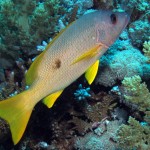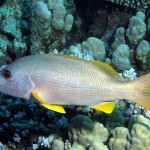Species: Lutjanus monostigma
English Name: One-spot Snapper
Chinese Name: 單斑笛鯛
Family: Lutjanidae
Description:
Adults One-Spot Snapper are grey or yellowish grey to brown with yellow fins. At night these snappers are brown to red in color. The black side spot can be turned on or off at will. Can grow up to a length of 60 cm. Lives in coral reef areas, usually close to shelter in the form of caves, large coral formations and wreckage. Preys on fishes and benthic crustaceans at night. Commercialized for human use.


Photos used under a Creative Commons license
References:
– Allen, G.R., 1985. FAO Species Catalogue. Vol. 6. Snappers of the world. An annotated and illustrated catalogue of lutjanid species known to date. FAO Fish. Synop. 125(6):208 p. Rome: FAO.

